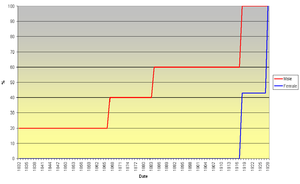Reform Act
In the United Kingdom, Reform Act is most commonly used for legislation passed in the 19th century and early 20th century to enfranchise new groups of voters and to redistribute seats in the House of Commons of the Parliament of the United Kingdom.
Reform Acts[]

The parliamentary franchise in the United Kingdom was expanded and made more uniform through a series of Reform Acts beginning with the Great Reform Act in 1832.[1] Sources refer to up to six "Reform Acts",[2][3][4] although the earlier three in 1832, 1867/8 and 1884 are better known by this name.[5] Some other acts related to electoral matters also became known as Reform Acts.[6][7] There are many other electoral reform acts in the United Kingdom that are not known by the name "Reform Act". Such legislation typically used the short title of Representation of the People Act, by which name the 1918, 1928 and other acts in the 20th century are better known and a term that was adopted in other countries around the world.[note 1][note 2]
- Reform Act 1832 (often called the "Great Reform Act" or "First Reform Act"),[8] which applied to England and Wales and gave representation to previously underrepresented urban areas and extended the qualifications for voting.
- Scottish Reform Act 1832, a similar reform applying to Scotland.
- Irish Reform Act 1832, a similar reform applying to Ireland.
- Reform Act 1867 (also called the "Second Reform Act"),[9] which widened the franchise and adjusted representation to be more equitable.
- Scotland, 1868, a similar reform applying to Scotland.
- Ireland, 1868, a similar reform applying to Ireland.
- Ballot Act 1872 (sometimes called the "Reform Act of 1872"), which introduced the secret ballot.
- Corrupt and Illegal Practices Prevention Act 1883 (sometimes called the "Reform Act of 1883"), which introduced campaign spending limits.
- Reform Act 1884 (also called the "Third Reform Act"),[10] which allowed people in counties to vote on the same basis as those in towns. Home ownership was the only qualification.
- Redistribution of Seats Act 1885 (sometimes called the "Reform Act of 1885"),[6][7] which split most multi-member constituencies into multiple single-member ones.
- Reform Act 1918 (also called the "Fourth Reform Act"),[11][12] which abolished property qualifications for men and introduced limited female suffrage, for women over the age of 30.
- Reform Act 1928 (also called the "Fifth Reform Act"),[13][14] which widened suffrage by giving women electoral equality with men.
- Reform Act 1969 (also called the "Sixth Reform Act"),[2][3][4] which lowered the minimum voting age from 21 to 18.
Modern usage[]
The periodic redrawing of constituency boundaries is now dealt with by a permanent Boundary Commission in each part of the United Kingdom, rather than by a Reform Act.[15]
Some people in Britain, mostly associated with the Liberal Democrat political party, have called for a new "Great Reform Act" to introduce electoral changes they favour. These would include lowering the minimum voting age to 16 and introducing proportional representation.[16][17][18]
See also[]
- Elections in the United Kingdom § History
- Representation of the People Act
- Sixth Periodic Review of Westminster constituencies
- Suffrage § United Kingdom
- Universal suffrage § Dates by country
- Westminster system
Notes[]
References[]
- ^ Bedarida, Francois (2013-06-17). A Social History of England 1851-1990. Routledge. ISBN 978-1-136-09732-4.
- ^ a b Kitching, Paula. "Political Reform: Lesson Plan 6: Overview" (PDF). The History of Parliament. p. 3.
Create one of the following charts for each of the six Reform Acts
- ^ a b "1969 Representation of the People Act". www.parliament.uk. Retrieved 2021-01-02.
1969-sixth-reform-act
- ^ a b "Members of Parliament Chadderton". www.chadderton-historical-society.org.uk. Retrieved 2021-01-02.
Act of 1969 (also known as the Sixth Reform Act)
- ^ Johnston, Neil (2021-02-01). "The History of the Parliamentary Franchise".
Reform Acts of 1832, 1867/8 and 1884
Cite journal requires|journal=(help) - ^ a b Wright, D. G. (2014-07-30). Democracy and Reform 1815 - 1885. Routledge. ISBN 978-1-317-88325-8.
- ^ a b writer.), Andrew Reid (political (1887). We must fight it out!-And why?.
- ^ Evans, Eric J. (2008-01-28). The Great Reform Act of 1832. Routledge. ISBN 978-1-134-81603-3.
- ^ Francis Barrymore Smith (1966). The Making of the Second Reform Bill. CUP Archive.
- ^ Hayes, William A. (1982). The Background and Passage of the Third Reform Act. Garland Pub. ISBN 978-0-8240-5156-3.
- ^ Dawson, Michael (25 March 2010). "Money and the real impact of the Fourth Reform Act". The Historical Journal. 35 (2): 369–381. doi:10.1017/S0018246X0002584X.
- ^ Tanner, Duncan (1983). The Parliamentary Electoral System, the Fourth Reform Act and the Rise of Labour in England and Wales.
- ^ Albjerg, Victor Lincoln; Albjerg, Esther Marguerite Hall; Albjerg, Marguerite Hall (1951). Europe from 1914 to the Present. McGraw-Hill. p. 257.
- ^ Cole, G. D. H. (2018-12-07). British Working Class Politics, 1832-1914. Routledge. ISBN 978-0-429-82018-2.
- ^ Johnston, Neil (2021-02-01). "Constituency boundary reviews and the number of MPs". Cite journal requires
|journal=(help) - ^ Stone, Greg (2009-07-30). "It's time for the next Great Reform Act". The Guardian. ISSN 0261-3077. Retrieved 2021-01-02.
- ^ Toynbee, Polly (2014-01-31). "Giving 16-year-olds the vote can be Labour's Great Reform Act". The Guardian. ISSN 0261-3077. Retrieved 2021-01-02.
- ^ "A new Great Reform Act is needed to limit the absurdities of our constitution". The Independent. 2015-05-06. Retrieved 2021-01-02.
Further reading[]
- Conacher. The Emergence of British Parliamentary Democracy in the Nineteenth Century: The Passing of the Reform Acts of 1832, 1867, and 1884-1885. (Major Issues in History). John Wiley and Sons. 1971. Google Books.
- Brown, Richard. "The Reform Acts". Church and State in Modern Britain 1700-1850. Routledge. 1991. Pages 220 to 227.
- Briggs, Asa The Age of Improvement 1783-1867 (1959)
- Woodward, Llewellan. The Age of Reform, 1815–1870 (2nd ed. 1961)
- Laws in the United Kingdom
- Legal history of the United Kingdom
- Political history of the United Kingdom
- Constitution of the United Kingdom